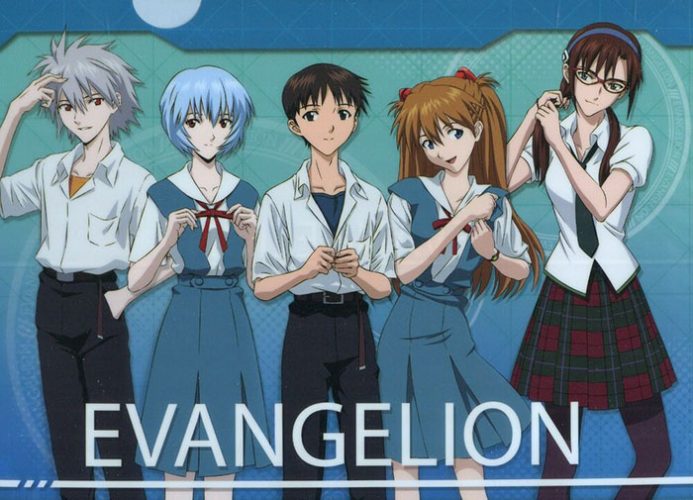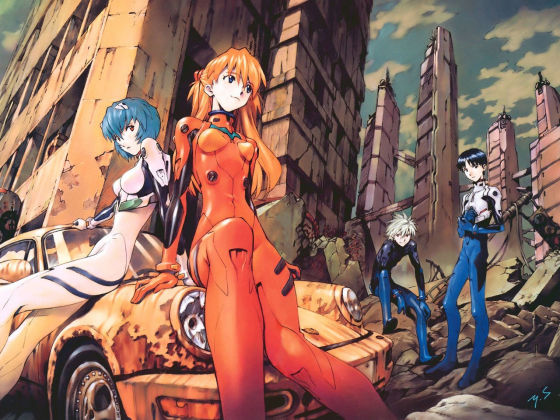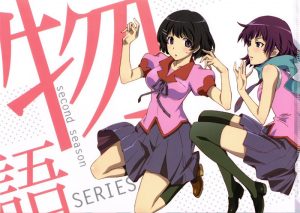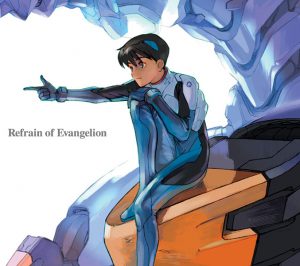
In part 1, we laid out our preferred watch order for the main installments of the Neon Genesis Evangelion franchise. This time, we’ll be taking a closer look at some of the optional content that expands the series’ universe and offers new perspectives on its iconic story. We’ll also explore the production history of the anime and shed some light on why Hideaki Anno chose to structure the series this way. Come join us!
(Optional) Rebuild of Evangelion: 1.0, 2.0, and 3.0
The feature films Evangelion: 1.0 You Are (Not) Alone, 2.0 You Can (Not) Advance, and 3.0 You Can (Not) Redo were released several years apart in the late 2000s and early 2010s. Together, they comprise the Rebuild of Evangelion series, which uses spectacular digital animation to retell the events of the anime with slight differences early on and an entirely original storyline for the third film. There’s supposedly a fourth one in the works, but expect Half Life 3 and the second season of No Game No Life to come out before that does.
Even though the first two movies are largely recaps, it’s best to watch all three of them because key details like Asuka’s backstory and the identity of the Fourth Child have been changed. It all leads up to 3.0, where Shinji wakes up 14 years in the future and has to piece together what happened while developing a much deeper relationship with Kaworu than he did in the original series. If you love modern animation and can’t get enough Evangelion in your life, give the Rebuild trilogy a try.
Other Optional Content
Of course, such a monolith of Japanese pop culture has to have more installments than just one anime and a few movies. These range from detective adventure games to themed soundtrack albums to more high school spinoffs than we can possibly count, none of which were written by Anno himself. Here are a few of our favorites:
Neon Genesis Evangelion manga – This manga ran from 1995 to 2013 and features different interpretations of Anno’s characters. Gendo is closer to a main character and the connection between Unit-01 and Shinji’s mother is more deeply explored. Viz’s 3-In-1 volumes also contain extra essays and author comments that shed new light on some of the series’ more esoteric parts.
Shinji Ikari Raising Project – One of several strangely popular raising sims/visual novels that depict Shinji and the other kids in a normal high school, a la the dream sequence from episode 26 of the anime. It also has a manga adaptation that’s still running to this day, and the best part of this game is that you can actually date Kaworu!
Neon Genesis Evangelion (3 Years After) ANIMA – A light novel that explores an alternate future where the Human Instrumentality Project never happened. It’s a less depressing take on the series and features new mecha designs and storylines for our main characters. Seven Seas Entertainment is planning on releasing the novel in English in October of 2019.
How We Got Here
The story of how Neon Genesis Evangelion reached its current form is... complicated. Director Hideaki Anno had fallen into depression after pouring his heart and soul into Gainax’s previous two film projects—Nadia: The Secret of Blue Water and a failed sequel for Royal Space Force. As a result, his simple idea of an anime about “not running away” spiraled into madness as he flitted between ideas and scripts while the episodes were being animated. Preview clips for episode 25 had to be discarded once Anno changed his mind at the last minute for the millionth time.
He began to focus more on his characters’ minds than the story itself, spurred on by a book on mental illness that his friend had lent to him. If you’re a fan of Freudian psychology and the like, you’ll notice references to the Oedipus complex, the libido-destrudo conflict, and others. But really, this is all just set dressing for intriguing character interactions that we can understand with our own words. The same goes for the Judeo-Christian terminology like Adam and the Tree of Life, which were chosen because they would sound cool and exotic to Japanese viewers.
After episodes 25 and 26 aired, fans wrote angry letters to Anno and parents ramped up the cries for censorship that they’d been trumpeting all along. These incidents heavily influenced The End of Evangelion, where images of death threats and graffiti flashed across the screen during some of the movie’s tensest moments. Anno and the production team suffered under the weight of their own projects, and it’s a miracle that this series was finished at all. But now, it’s the most successful property Gainax has ever produced.
Final Thoughts

When you strip away the incomprehensible vocabulary and messy narrative structure of Neon Genesis Evangelion, you’re left with the most real and relatable depiction of people with mental illness that we’ve ever seen. You’ll find someone to relate to in this anime, no matter who you are. And that’s why we love it so much.
What did you think of our watch order breakdown? What are your favorite installments in the Evangelion franchise? Let us know in the comments, and thanks so much for reading!
Recommended Post



